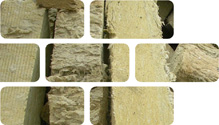
Stone Wool Insulation 17 06 04
Stone wool insulation board, tile, blanket or pipe is a fibrous product spun from naturally occurring volcanic diabase rock and slag, then manufactured into a wide range of products, sizes, thicknesses and density depending on the performance and specification required. Some stone wool products are combined with facing materials including sheet metal, foil, plasterboard and polythene to suite the technical or architectural finish required.
Usage & Probable Locations
Stone wool insulation is mostly used for insulating cavity walls, floor voids, ceilings, stud walls, curtain walls, rainscreen walls, pipes and panel systems. It is used as an acoustic barrier and for the protection of buildings against fire. It may also be used in structural insulated panels for roofing and cladding of commercial and industrial buildings. It is sometimes used as an insulated wall board and lagging of steam/hot water pipes.
Personal Protective Equipment
PPE requirements indicated are for guidance purposes only. DRIDS has identified the PPE that is mandatory on all demolition projects and ones that may be required subject to site specific Risk Assessment & Method Statement (RAMS). Hover over the icon to determine the types of PPE required for the removal of this material.
Removal, Segregation & Storage
Stone wool insulation products that are in good condition and not contaminated by other materials may have some recycling or recovery value. They should be carefully removed, segregated and stored in a covered skip to avoid contamination. Manufacturers of stone wool may recover uncontaminated materials for recycling back into products, with some achieving up to 95% recyclate. Stone wool insulation destined for landfill should be segregated from hazardous materials and placed in a mixed waste skip.
Tools
Fixtures, Fittings & Connections
Stone wool insulation is commonly fixed in place with nails or underneath roofing sheets with mechanical screws, hook bolts or drive nails. For cavity walls, inbetween trusses or above/below/ inbetween suspended and concrete floors, the stone wool insulation sheets will be tightly run between other products, or just laid in place over or under products. Thermal laminated boards containing plasterboard, stone wool insulation and insulating film are bound together with adhesives and difficult to separate. Foil coated stone wool is easier to separate and more suitable for recycling.
Health & Safety
Subject to task-specific Risk Assessment & Method Statement (RAMS). Use correct protective equipment for removing fixings, especially nails and screws. Wear gloves when handling sheets with damaged edges, coated with insulating or decorative film to prevent irritation, cuts and friction burns. Wear eye protection when removing nails or screws with a crowbar, hammer or nailbar. Wear face mask when handling stone wool products to prevent inhalation of dust and particulates.










